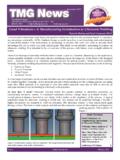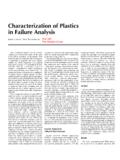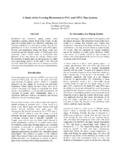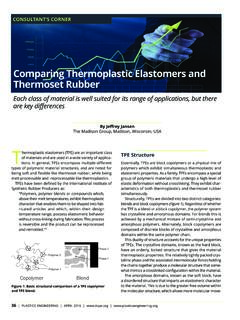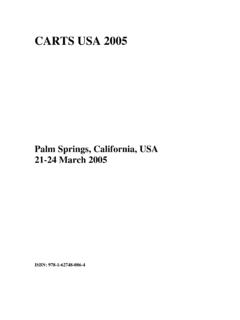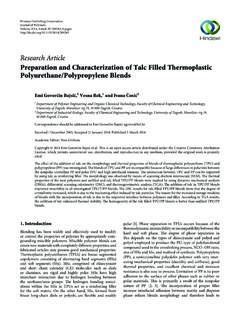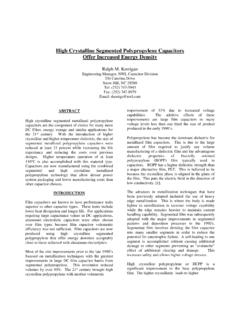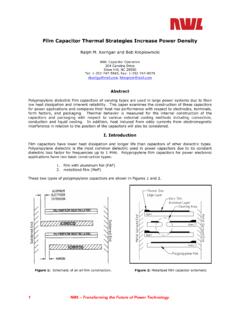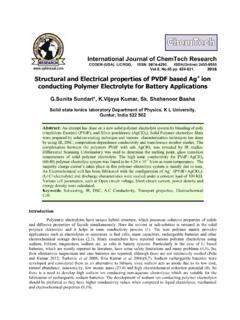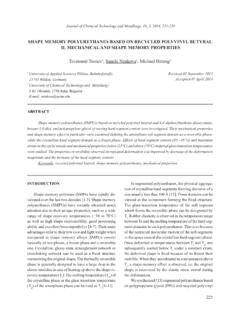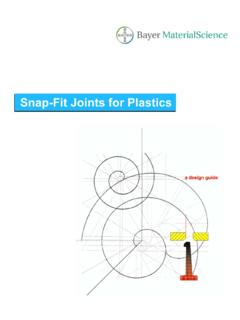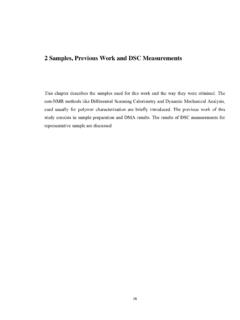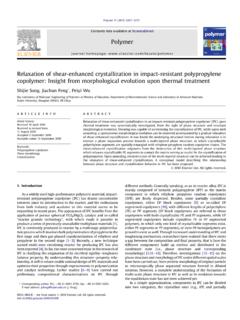Transcription of Comparing Thermoplastic Elastomers and Thermoset Rubber
1 CONSULTANT S CORNERC omparing Thermoplastic Elastomers andThermoset RubberEach class of material is well suited for its range of applications, but thereare key differencesBy Jeffrey JansenThe Madison Group, Madison, Wisconsin, USAT hermoplastic Elastomers (TPE) are an important classof materials and are used in a wide variety of applica-tions. In general, TPEs encompass multiple differenttypes of polymeric material structures, and are noted forbeing soft and flexible like Thermoset Rubber , while beingmelt-processable and -reprocessable like have been defined by the International Institute ofSynthetic Rubber Producers as: Polymers, polymer blends or compounds which,above their melt temperatures, exhibit thermoplasticcharacter that enables them to be shaped into fab-ricated articles and which, within their designtemperature range, possess elastomeric behaviorwithout cross-linking during fabrication. This processis reversible and the product can be reprocessedand remolded.
2 1 TPE StructureEssentially, TPEs are block copolymers or a physical mix ofpolymers which exhibit simultaneous Thermoplastic andelastomeric properties. As a family, TPEs encompass a specialgroup of polymeric materials that undergo a high level ofelastic deformation without crosslinking. They exhibit char-acteristics of both thermoplastics and Thermoset , TPEs are divided into two distinct categories:blends and block copolymers (Figure 1). Regardless of whetherthe TPE is a blend or a block copolymer, the polymer systemhas crystalline and amorphous domains. For blends this isachieved by a mechanical mixture of semi-crystalline andamorphous polymers. Alternately, block copolymers arecomposed of discrete blocks of crystalline and amorphousdomains within the same polymer duality of structure accounts for the unique propertiesof TPEs. The crystalline domains, known as the hard block,have an orderly, locked structure that gives the materialthermoplastic properties.
3 The relatively tightly packed crys-talline phase and the associated intermolecular forces holdingthe chains together produce a molecular structure that some-what mimics a crosslinked configuration within the amorphous domains, known as the soft block, havea disordered structure that imparts an elastomeric characterto the material. This is due to the greater free volume withinthe molecular structure, which allows more molecular move-Figure 1: Basic structural comparison of a TPE copolymerand TPE | PLASTICS ENGINEERING | APRIL 2016 | | | | APRIL 2016 | PLASTICS ENGINEERING | 37ment. The functionality of the hard blocks and soft blocksis similar between both blended and block copolymer copolymer-based TPEs are based upon polymersthat have hard blocks and soft blocks along the backboneof the polymer chain. As a bulk response, solidification fromthe melt state results in coalescence of the crystallinedomains into hard blocks, resulting in characteristic ther-moplastic behavior.
4 Conversely, the amorphous domainsform elastomeric bridges, otherwise known as tie molecules,representing soft blocks that give an elastomeric produced through the blending of materials arecommonly based upon amorphous domains (the elastomer-ic phase) within hard domains (the thermoplasticphase) although the reverse can also be true, with somematerials consisting of hard domains in a soft elastomericbase of whether the TPE material is a copolymer ora blend, the hard block will have a melting point, or less com-monly a glass transition temperature, well above roomtemperature. Accordingly, the soft block will have a glasstransition temperature, or less frequently a melting point,well below room properties can be obtained and tailored by selec-tive combination of the structure and ratios of individualhard phases and soft phases. While both the hard and softphases contribute to the overall physical and mechanicalproperties of a TPE, some key properties may be more close-ly associated with one domain or the other.
5 Some of thekey properties associated with the individual phases areindicated in Table of TPEs and RubbersThere are six generic classes of commercial TPEs: styrenic block copolymers (SBC): block copolymers andterpolymers of styrene and butadiene; polyolefin blends (TPO): blends of polypropylene andun-crosslinked poly(ethylene propylene diene monomer)(EPDM) Rubber ; elastomeric alloys (TPV): blends of polypropylene andvulcanized (cross-linked) EPDM Rubber ; Thermoplastic polyurethanes (TPU): linear segmentedblock copolymers formed by the reaction of diiso-cyanates with short-chain diols and diisocyanates withlong-chain diols; Thermoplastic copolyesters (COPE): copolymers of bifunc-tional aromatic polyesters with ether linkages; and Thermoplastic polyamides (PEPA): copolymers obtainedby polycondensation of a carboxylic acid polyamide withan alcohol-terminated contrast to Thermoplastic Elastomers , Thermoset rubbersare single-phase materials, without the dual hard and softphases.
6 Rubber materials are natural or synthetic polymermacromolecules, and can be polymerized as homopolymersor random structure of Rubber is amorphous, exclusive of crys-talline domains. Because of this, Rubber materials undergoa glass transition, but no melting point. By definition, ther-moset Rubber materials have a glass transition temperaturebelow room temperature. This is in contrast with thermosetplastic materials, which have a glass transition temperatureabove ambient addition to the intermolecular bonds holding the poly-mer chains together, similar to that of TPEs, Rubber materialshave non-reversible covalent chemical bonds binding theindividual chains together. These chemical bonds, orcrosslinks, are formed during molding through a processknown as vulcanization, alternatively known as crosslinkingor curing. There are a wide variety of types of Thermoset rubbermaterials, with the following representing some of the mostcommon, with their common abbreviations: natural Rubber (NR); polyisoprene (IR); polychloroprene (CR); styrene butadiene Rubber (SBR); nitrile butadiene Rubber (NBR); ethylene propylene diene monomer Rubber (EPDM); butyl Rubber (IIR); polybutadiene (BR); epichlorohydrin (ECO); fluorinated hydrocarbon (FKM); and silicone Rubber (Q).
7 The crosslinking process within Thermoset Rubber is achemical reaction that takes place at a relatively high tem-perature during the molding process. The most commoncrosslinking agents are sulfur, sulfur-containing chemicals,and Thermoplastic Elastomers and Thermoset rubbermaterials get their principal properties from the base poly-mer. However, both types of materials contain formulationadditives that modify and enhance the final properties ofthe compounds. These additives commonly include rein-forcing fillers, non-reinforcing fillers, plasticizers, stabilizersand anti-degradants, process aids, and many types of specificTable 1: Key Properties Closely Associated with Crystalline orAmorphous Domains of TPEsperformance enhancers. Thermoset Rubber compoundsalso contain curatives, as well as cure activators and accel-erators to enhance the crosslinking ComparisonOn a basic level, Thermoplastic Elastomers exhibit someof the characteristics of Thermoset Rubber , but above theirmelt or softening temperatures, are melt processable likethermoplastics.
8 This allows TPEs to be reprocessed andremolded. In the viewpoint of those familiar with thermo-plastics, TPEs allow for ease of fabrication and designflexibility not afforded by Thermoset with other Thermoplastic materials, TPEs offeradvantages in properties including: softness: low hardness; flexibility: low modulus; impact strength; tear and abrasion resistance; fatigue resistance; desirable compression set; broad use-temperature range; chemical resistance; and low specific , Thermoset Rubber compounds offer distinctperformance advantages over TPEs due to their crosslinkedstructure. Absolute properties will be highly dependenton the exact compounds being compared. A general prop-erty comparison is presented in Table 2, illustrated alsoby Figure indicated in Table 2, the advantages of TPEs are pre-dominately in the area of processing, while Thermoset rubbertypically is superior in regards to performance properties,especially those related to temperature, chemical contact,and sustained stress.
9 In all fairness, the advantages indicatedin ease of compounding and ease of molding are basedupon one s viewpoint. For those familiar with working withthermoset Rubber compounds, a difference of opinion maybe types of materials, Thermoplastic Elastomers andthermoset rubbers, are diverse classes of polymeric materialsoffering a wide range of properties. A comparison showsthat the inherent properties are dependent on the differentstructures comprising the two sets of materials, as well asformulation best material for a particular application will dependon many parameters, including the design of the componentand the service conditions. Designers of articles and assem-blies should be well familiar with both thermoplasticelastomers and Thermoset rubbers in order to choose themost appropriate material to ensure the best chance forproduct See also:J. A. Brydson, Thermoplastic Elastomers : Properties andApplications, Rapra Review Reports, vol. 7, no. 9, 1995, p.
10 3. About the A. Jansen is a senior managing engi-neer and partner at The Madison Group, an independent plasticsengineering and consulting firm. He specializes in failure analysis,material identification and selection, and aging studies for ther-moplastic materials. Jansen is a regular contributor to PlasticsEngineering s Consultant s Corner and a regular presenterfor SPE s webinar series, covering a wide range of topics relatedto plastics failure, material performance, testing, and : Jeff Jansen will be offering two upcoming SPE webinarsrelated to Elastomers : Basic Rubber Technology, on May 12,and Thermoplastic Elastomers , on Nov. 10, 2016. Register | PLASTICS ENGINEERING | APRIL 2016 | | S CORNERC omparing TPEs and Thermoset Rubber _____Table 2: Property Comparison of TPEs and Thermoset RubberFigure 2: Basic applications of TPEs (overmolded toothbrushhandle) and Thermoset Rubber (tires).
